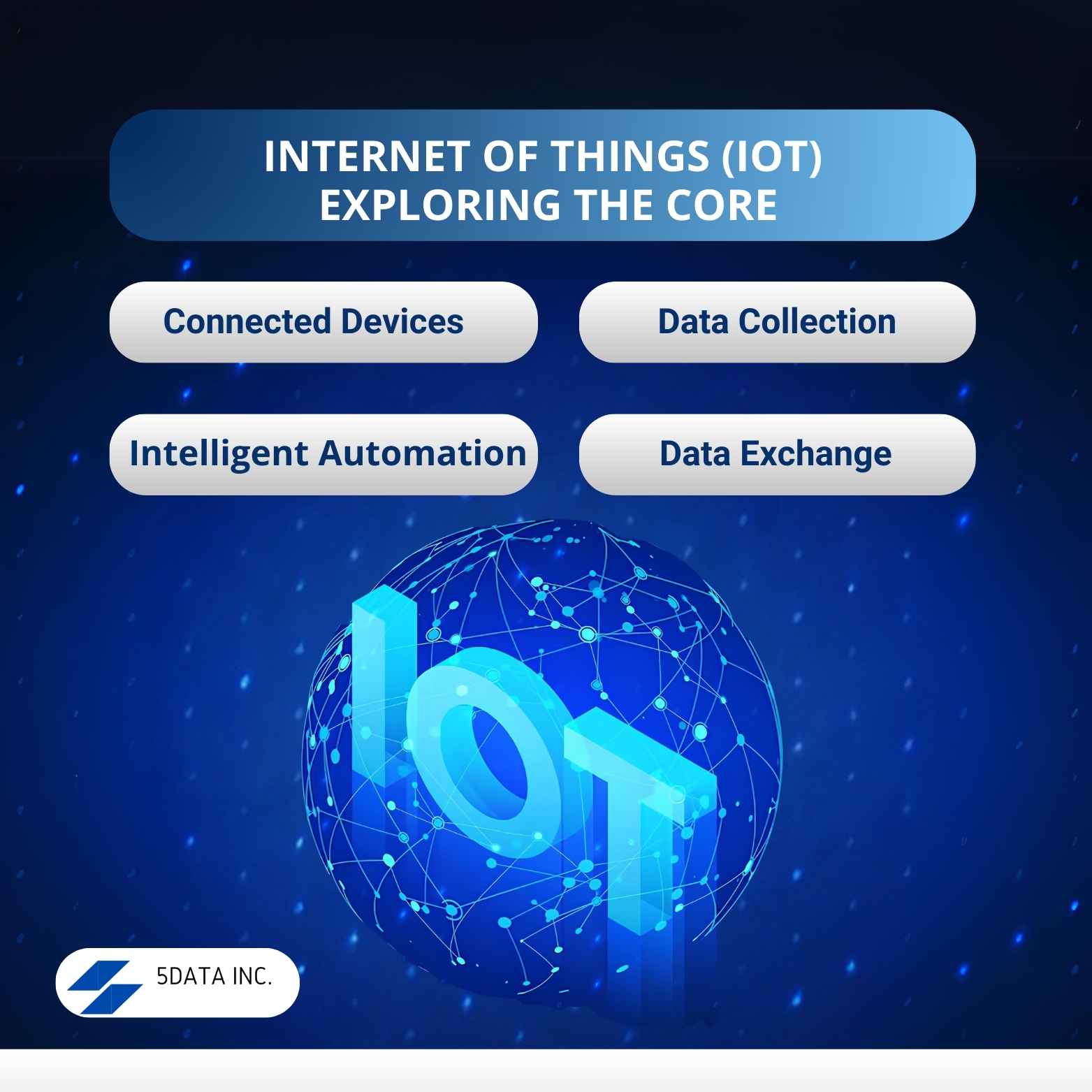AI may get the glory for its data analysis and decision-making capabilities, but it’s the vast network of interconnected devices – the IoT – that plays a crucial role. This blog post discusses the critical role of IoT system frameworks, the unseen service-oriented architecture that controls the data processing from computing devices to powerful AI applications, ultimately enabling smarter automation across various devices and industries.
What we cover in this blog
Key Takeaways
- IoT connects billions of devices for real-time data collection and smart automation.
- Sensors gather data, transmit it to hubs, and AI automates decisions.
- IoT frameworks simplify device integration, data management, and security.
- Open-source IoT frameworks are customizable and cost-effective but require strong programming skills.
- Proprietary IoT frameworks are user-friendly and scalable but can be costly and lead to vendor lock-in.
Internet of Things (IoT)
The Internet of Things (IoT) is a novel concept. It consists of a vast network of Internet-connected devices – from thermostats and wearables to industrial machinery – embedded with software, wireless sensor networks, and other web services. These devices connect and exchange data with each other over the Internet, creating a powerful ecosystem of interconnected intelligence. The IoT analytics predicts that by 2027, this network will encompass a staggering 29 billion connections.
The stats are interesting!
Let’s dive into its core concept:
- Connected Devices: Imagine the practical benefits of your refrigerator automatically reordering milk when it detects low stock. Or the comfort of smart thermostats that adjust the temperature based on your timing. These are just a few examples of IoT devices becoming ‘smart.’
- Data Collection: Sensors embedded in these devices constantly gather real-time data about their environment. These data points could be temperature readings, pressure measurements, or even motion detection.
- Data Exchange: The data generated is then transmitted wirelessly to a central hub or cloud computing platform. It allows for remote monitoring, analysis, and control of the devices.
- Intelligent Automation: With the help of natural language processing and machine learning algorithms, IoT systems can make automated decisions. It helps in proper process control and resource management.

IoT in Smart Home Automation
Smart homes are a great example of how IoT systems are. Here’s a breakdown:
- Sensors: These are the eyes and ears of your smart devices, detecting things like temperature, motion, or light levels.
- Communication: Sensors send data to a central hub (often called a gateway) through Wi-Fi, Zigbee, or Z-Wave.
- Automation: The hub interprets the data and triggers actions based on your preferences. For example, a smart water sensor placed under your sink. When it detects a leak, these IoT devices automatically shut off the water supply through a connected smart valve.
IoT Framework
An IoT framework is a collection of tools, protocols, and pre-built functionalities that simplify the process of building and managing IoT applications.
Here’s why frameworks are crucial in the age of exploding IoT:
- Streamlining Device Connectivity: Integrating billions of devices with applications can be a daunting task. Frameworks provide standardized protocols and APIs (application programming interfaces) that simplify device discovery, data capture, and data security.
- Data Management is Simple: The data collected by these electronic devices is the lifeblood of IoT sensors. Frameworks offer built-in data management tools for data acquisition and data aggregation. For instance, smart factory farming might use the proposed system to collect real-time sensor data using radio frequency identification on soil moisture and weather conditions. The framework would then organize and analyze this massive data, enabling farmers to optimize irrigation and improve crop yields.
- Security and Scalability: A secure connection is extremely important when dealing with different devices. The proposed framework offers built-in security features like encryption and access control to safeguard sensitive environmental data. Additionally, these embedded devices are designed to be scalable, allowing applications to transmit data between multiple devices efficiently.
Bring your app idea to life – expert application development services for all visions.
Types of IoT Frameworks
There are two main options – open-source and proprietary.
Open-Source Frameworks
Imagine a workshop brimming with tools and materials, all readily available for your needs. That’s the essence of open-source IoT frameworks. They provide the core functionalities – device connectivity, data management, and application integration – with complete access to the source code. This transparency allows for:
Customization: Open-source frameworks offer unparalleled flexibility. Developers can modify the code to tailor the framework to specific project requirements. Need to integrate with a unique sensor or implement a custom security protocol? Open-source frameworks empower you to make these adjustments.
Community Support: Developers from around the world contribute to the online communities, providing valuable resources like tutorials, bug fixes, and code libraries. If you encounter a challenge in the IoT system, a helpful answer is just a forum post away.
Cost-Effectiveness: Open-source frameworks are typically free to use, eliminating licensing fees and making them an attractive option for startups and budget-conscious projects.
Some popular open-source frameworks include ThingsBoard, OpenHab, and DeviceHive.
However, open-source frameworks also come with certain considerations:
Development Expertise: Modifying code requires strong programming skills. If your team lacks experience, open-source frameworks might necessitate additional development resources.
Security Risks: Since anyone can access the source code, IoT security vulnerabilities might be more challenging.
Limited Support: While online communities exist, dedicated technical support from a vendor might be unavailable, potentially hindering troubleshooting.
Proprietary Frameworks
Think of a well-equipped laboratory with pre-configured physical devices and expert technicians at your disposal. It is the experience offered by proprietary frameworks. Developed and maintained by vendors like Amazon (AWS IoT), Microsoft (Azure IoT), and Google (Cloud IoT Core), they provide:
Ease of Use: Drag-and-drop interfaces and pre-built functionalities simplify development, helping you to focus on application logic rather than intricate device communication protocols.
Scalability and Security: Leading vendors invest heavily in ensuring their frameworks are secure, scalable, and have good data analytics. These can be critical for large-scale deployments.
Vendor Support: Proprietary frameworks come with comprehensive technical support from the vendor. These can be invaluable when troubleshooting complex issues or seeking optimization advice.
Some Popular Proprietary Frameworks include AWS IoT, Azure IoT, and IBM Watson IoT.
Wireless communication with efficient energy management is hassle-free with the software application development company.
However, proprietary frameworks also have limitations:
Cost: Licensing fees can add up quickly, especially for large-scale deployments.
Vendor Lock-In: Once you choose a proprietary framework, switching vendors becomes more complex. These can limit your flexibility in the long run.
Limited Customization: Proprietary frameworks offer less flexibility for customization compared to open-source options. It can be a constraint if you need proper software-defined networking protocols.
Conclusion
The explosion of connected devices demands robust frameworks to orchestrate their data flow and unlock smarter automation. 5Data Inc., with its expertise in application development services, can help you build smart cities and harness the power of the Internet of Things in the digital world. We are just a click away.
Frequently Asked Questions (FAQs)
Which framework is used for IoT?
Think of them as toolkits that simplify connecting devices, managing data, and building IoT applications. (e.g. AWS IoT, Azure IoT)
What is device integration in IoT?
It’s like adding devices to your team! It’s the process of connecting devices to a network so they can talk to each other.
Which two devices are commonly used to connect IoT devices to a home network?
Devices often use Wi-Fi routers or gateways to join your home network.

About the Author...
Almaas Saleem is a skilled software engineer from Kerala, India who currently resides in East Africa. She is passionate about technology and constantly seeks to learn more about it through reading and hands-on experience. Almaas excels in web development, design, automated testing software, ethical hacking, cybersecurity, and digital marketing. She also works as a technical writer for new businesses, managing various entities. Almaas is distinguished by her steadfastness and commitment to her work, which consistently yields excellent results.
